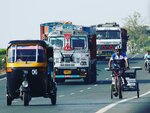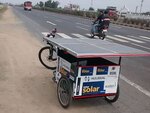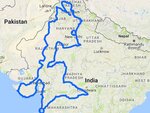Hi guys! I'm moving some content off of the main site and into the most relevant categories of the forum. This post was originally made on December 22nd 2016:

In 2016 Sushil Reddy took on the ultimate challenge, riding an electric bike more than 4,600 miles (7,500 Kilometers) across nine states in India! He had to deal with a wide range of street conditions, different languages and finding enough electricity along the way to keep his ebike charged… Actually, the last challenge was solved through the use of a trailer covered with flexible solar panels that offered ongoing solar charging! Sushil has written a book about the trip which you can get on Amazon here and some of the proceeds are going to help a local school update facilities and install solar themselves… Sushil agreed to answer a few questions about the ride that might benefit others planning to do a long distance multi-state or multi-country ebike trek like his. My questions and his answers follow:




In 2016 Sushil Reddy took on the ultimate challenge, riding an electric bike more than 4,600 miles (7,500 Kilometers) across nine states in India! He had to deal with a wide range of street conditions, different languages and finding enough electricity along the way to keep his ebike charged… Actually, the last challenge was solved through the use of a trailer covered with flexible solar panels that offered ongoing solar charging! Sushil has written a book about the trip which you can get on Amazon here and some of the proceeds are going to help a local school update facilities and install solar themselves… Sushil agreed to answer a few questions about the ride that might benefit others planning to do a long distance multi-state or multi-country ebike trek like his. My questions and his answers follow:
- Q. What an undertaking Sushil! Sounds like a once in a lifetime adventure and I’m sure a lot of planning went in. What are three things that could have been easily overlooked or forgotten but really came in handy or were crucial for your success?
A. It was an experience of a lifetime, absolutely. I was planning this ride from 3 months prior to the actual ride start. The idea of the ride was primarily to raise awareness about solar energy in India by interacting with people along the route. Hence I chose to ride a solar powered electric bike to demonstrate a real-life application of solar energy. Riding in the summer was a challenge, especially in Rajasthan where the temperatures were more than 45 degree celsius (~113 fahrenheit). I had a team of 3 people – Rajendra Bhaskar, Krunal Tailor, Himanshu Singh with me in a support vehicle which came in handy on many occasions. The ride needed a lot of dedication and patience from all 4 of us to execute the route. So the 3 things which were very crucial for my ride were – 1. Hydration during the ride – Very crucial for summer rides to keep oneself hydrated, drinking sips of water and juices frequently to avoid cramps and weakness. I was riding in peak summer and we carried a lot of hydration in the support vehicle. 2. A good quality electric bicycle – You do not want frequent breakdowns during the ride. Hence a lot of time and effort was given to having the good quality ebike and the trailer for solar panels. Hulikkal Electro India Pvt. Ltd. makes good quality ebikes and they converted one of their models to electric for me. 3. A great team with mental fitness – A long distance journey is made easier with a great team. This was crucial because we shared the responsibilities of planning the onward journey. The right people made the journey that much easier. - Q. Which electric bicycle did you choose to ride for this tour and how did it hold up… honestly. What broke and how did you deal with it on the road? It sounds like some of the roads you traveled were pretty rough… What are some other bikes that you’d recommend for an adventure like this or some features you’d view as absolutely necessary to make it.
A. I used an electric bicycle sponsored by Hulikkal India Pvt. Ltd. It was a custom frame MTB with a retrofitted ebike kit of 250 Watt rear Hub Motor and a 48V lithium Ion Battery pack. Mr. Faisal Thakur of Pro9 Bicycle Studio in Mumbai customised the rear trailer with 240 watts of solar panels which was attached to the ebike. India has tough roads – very gravely, dusty and with potholes. the MTB stood up pretty well. There were a couple of punctures throughout the journey. We had spare tubes and tyres in the support vehicle so we fixed it on the road ourselves. Apart from this, no issues at all. Also in the hilly regions of Himachal Pradesh, we detached the solar trailer and carried with with the support vehicle to make climbing with the bike easier. This was essential since the roads were narrow and unsafe to ride with the trailer attached to the ebike. 250 Watts is the maximum motor power allowed in India without any license or registration for the vehicle. Hence I used a 250 watts motor ebike. It worked perfectly with the solar charging, I pedaled 50% of the time and the rest was taken by the motor. Carrying the solar panels along with the ebike increases the weight but reduces the effort especially for flats and small gradients. This is recommended for long distance touring in sunny regions. I would recommend going for slightly more than 250 watts (motor size) for long distance ebike touring since it will reduce the effort considerably and go well on climbs too. If you are doing a self-supporting journey, you can travel further with higher wattage motor since you will be carrying luggage too. I suggest that you plan your ride well in advance, take route reviews, have some contacts on the route and prepare mentally, so that you can withstand the rigor and challenge of riding so far and so long. I have not tried any other ebike brand so it is hard to say about my recommendations for other ebikes. But features for long distance travel I would say – 1. Light Weight Bike- since you are touring, you want to keep the weight as low as possible reducing the effort. 2. For roads in India – MTB is recommended since the road quality is generally average and only MTB tyres and frames can hold up to any kind of terrain. I am sure in the west, people use all kinds of tyres since the roads are much better. 3. For long distance touring, it is very essential to have basic spares (a couple of tubes, tyres) and a tool kit with basic things like allen key set and a puncture kit 4. Safety – a rear view mirror in India is a must, Helmet, front and rear lights is a must for long distance touring 5. Finally pre-ride preparation of the route, basic physical and mental fitness is necessary since long distance is about endurance. - Q. Solar charging is such a liberating concept… riding off the grid and powering yourself with the sun in a way that doesn’t adversely impact the environment or future generations through pollution. What solar panels did you use, how did you hook them up for charging and how did you bring them along? Any tips on how others can set something like this up?
A. I used 4 flexible solar panels imported by Taiwan connected in parallel (total 240 watts and 72 volts of output). The solar panels were flexible ones (4×4 inches) brought from a vendor in Taiwan via an Indian supplier Gogoa1 here. There were 4 panels of 60 watts each connected in parallel, so I had an output of 240 Watts, 70 volts and 3 amps. This was connected to the Lithium Ion Battery of 48 volts and 6 Ah via an MPPT charge controller (which is basically a circuit to regulate the voltage). I carried 2 similar batteries with me for the journey. I was using one while riding which was being charged on the go while being connected to the solar panels. One of them was in the support vehicle as a spare battery. The weight of these panels along with the trailer was approximately 10-15 kgs. The solar panels were attached to the ebike battery via a self made MPPT charge controller to regulate the voltage output from the panels and avoid battery damage. It is easy to do this. I have attached the image of the ebike with the solar trailer. I can help design the MPPT circuit if anyone wants it. People can get in touch with me. - Q. Despite having electric assist on your adventure, this was still a major physical undertaking… What stretches and exercises did you use to stay comfortable and avoid hurting yourself? Is there a limit to how far you can ride in one day?
A. I am not an athlete. I am a normal guy without any great physique. My target was 100 kms a day which is quite less since we were spending time talking to people and educating them about solar energy everyday. The basic arms and legs stretch in the morning everyday helped. Good padded shorts helped to stay on the saddle for long hours everyday. Moreover, mental preparation is more important than a physical one. - Q. Safety is important when you’re riding a bicycle, it doesn’t matter if you’re just circling the block or passing through a busy downtown area. This becomes even more important when you’re in a new unfamiliar landscape… What tactics did you use to stay safe? Did you only ride during daylight? What accessories did you get and use that made the journey safer?
A. A helmet is a must. India is not much cycling friendly. The traffic sense is missing among vehicles which makes it difficult for a cyclist to share the road with other vehicles, especially on highways. I have had some close shaves where trucks overtook me within inches of brushing past me. And, most importantly, I rode only during the day when there is enough light, so that we also got help with the solar power. On a couple of occasions I rode in the wee hours of the morning to avoid the afternoon heat. It was a safe ride overall. We took enough precautions while riding making sure that we respect the motorists, pedestrians and the basic road rules. - Q. Thanks for your time answering these questions, helping others. I’m excited to check out your book on Amazon and want to open up the final question for any closing thoughts you have about this adventure and the future of e-bikes for long distance transportation.
A. Thank you so much for this opportunity and spreading the word about the ebook and my journey. Solar energy is the way of the future and sustainability should be a norm. Our mission is to spread as much awareness about it and I thank EBR for being a part of this cause too. I think e-bikes and electric transportation is going to be the future of sustainable transportation, be it short or long distance. More and more people should adopt this technology and lifestyle change for a better future. Thank you again




Last edited:

